Heterotrophs Study guides, Class notes & Summaries
Looking for the best study guides, study notes and summaries about Heterotrophs? On this page you'll find 685 study documents about Heterotrophs.
Page 4 out of 685 results
Sort by
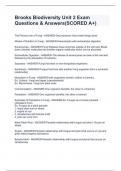
-
Brooks Biodiversity Unit 2 Exam Questions & Answers(SCORED A+)
- Exam (elaborations) • 17 pages • 2024
- Available in package deal
-
- $11.99
- + learn more
The Primary role of Fungi - ANSWER-Decomposers- they break things down Modes of Nutrition in Fungi - ANSWER-Heterotrophs with extracellular digestion Exoenzymes - ANSWER-Fungi Release these enzymes outside of the cell wall. Break down complex molecules into smaller organic molecules which can be absorbed. Extracellular Digestion - ANSWER-The release of exoenzymes out side of the cell wall, followed by the absorption of nutrients.. Saprobes - ANSWER-Fungi that feed on non-living/dead ...
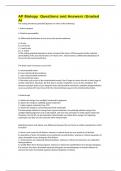
-
AP Biology Questions and Answers (Graded A)
- Exam (elaborations) • 70 pages • 2024
-
- $16.59
- + learn more
AP Biology Questions and Answers (Graded A) The resting membrane potential depends on which of the following? I. Active transport II. Selective permeability III. Differential distribution of ions across the axonal membrane A. III only B. I and II only C. II and III only D. I, II, and III D The resting potential depends on active transport (the Na+K+-ATPase pump) and the selective permeability of the axon membrane to K+ than to Na+, which leads to a differential distribution of ...

-
Principles of Biology Module 2 Notes
- Class notes • 46 pages • 2023
-
- $10.49
- 1x sold
- + learn more
These notes cover everything in Module 2 (Chapters 6-10) of BIOL1020 in depth with descriptions and diagrams. Chapter 6 starts with cells and covers prokaryotes, eukaryotes, all of the organelles, and different types of microscopy that is used to view cells. There is especially thorough information on each of the organelles and their structure and function. Chapter 7 goes in depth on the structure and function of membranes and membrane proteins. It also covers the different types of transport, p...

-
Biodiversity Unit 2 Exam—Brooks Latest Update Graded A+
- Exam (elaborations) • 14 pages • 2024
-
- $10.49
- + learn more
Kingdom Fungi -Decomposers -heterotrophs (w/ extracellular digestion) -saprobes -chitin Thallus body Mycelium what the body is made up of Hyphae thread like, where the nutrience is absorbed Septate more evolved, many cells divided by walls Coenocytic one huge cell with many nucleus, more primitiveHaustoria branching projections that push through cell walls into the living plant cells, absorbing nutrient Heterokaryon e.g. Dikaryon Dikaryon temporary stage during sexual reproduction bef...
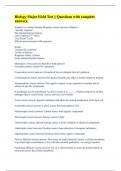
-
Biology Major Field Test || Questions with complete answers.
- Exam (elaborations) • 26 pages • 2024
- Available in package deal
-
- $14.69
- + learn more
Adaptive vs. Innate Immune Response correct answers Adaptive - "specific response" Has immunological memory Later response (3-7 days) Uses B and T cells Effectiveness increases with exposure Innate- "nonspecific response" 1st line of defense Response within 12 hours Lacks immunological memory Mutualism correct answers Benefit to both partners Normally partners cannot live seperately Cooperation correct answers A beneficial but not obligate form of symbiosis Commensali...
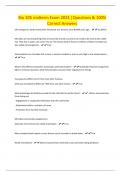
-
Bio 105 midterm Exam 2024 |Questions & 100% Correct Answers
- Exam (elaborations) • 14 pages • 2024
-
- $13.39
- + learn more
Life emerged on Earth shortly after the planet was formed, some BLANK years ago. - 3.8 billion Microbes are tiny living things that are found all around us and are too small to be seen by the naked eye. They live in water, soil, and in the air. The human body is home to millions of these microbes too, also called microorganisms - True Extremophiles are microbes that survive in intense conditions, such as very high or low temperatures. - True What is the difference between autotrophs and he...

-
Biology Major Field Test Questions with Verified Solutions
- Exam (elaborations) • 67 pages • 2024
- Available in package deal
-
- $11.99
- + learn more
Biology Major Field Test Questions with Verified Solutions Adaptive vs. Innate Immune Response Adaptive - "specific response" Has immunological memory Later response (3-7 days) Uses B and T cells Effectiveness increases with exposure Innate- "nonspecific response" 1st line of defense Response within 12 hours Lacks immunological memory Mutualism Benefit to both partners Normally partners cannot live seperately Cooperation A beneficial but not obligate form of symbiosi...
![AP Biology [Practice AP Exam] Questions and Answers (Graded A)](/docpics/5221272/663a5298645c3_5221272_121_171.jpeg)
-
AP Biology [Practice AP Exam] Questions and Answers (Graded A)
- Exam (elaborations) • 26 pages • 2024
-
- $10.39
- + learn more
AP Biology [Practice AP Exam] Questions and Answers (Graded A) [C] They Include compartments where hydrogen ions are concentrated. [1] Which of the following is true of both mitochondria and chloroplasts? ----------------------------------------------- [A] They are found in the cells of eukaryotic autotrophs and heterotrophs. [B] They include stacks of membranes that absorb light. [C] They Include compartments where hydrogen ions are concentrated. [D] They produce sugars using energ...
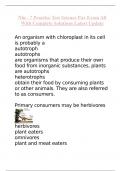
-
Nln - ? Practice Test Science Pax Exam All With Complete Solutions Latest Update
- Exam (elaborations) • 82 pages • 2024
-
- $14.49
- + learn more
An organism with chloroplast in its cell is probably a autotroph autotrophs are organisms that produce their own food from inorganic substances, plants are autotrophs heterotrophs obtain their food by consuming plants or other animals. They are also referred to as consumers. Primary consumers may be herbivores herbivores plant eaters omnivores plant and meat eaters Secondary consumers are carnivores, meat eaters, or omnivores that eat herbivores. Tertiary consumers are carnivor...
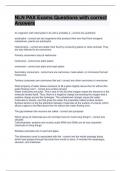
-
NLN PAX Exams Questions with correct Answers 2023/2024
- Exam (elaborations) • 26 pages • 2023
-
Available in package deal
-
- $13.99
- + learn more
NLN PAX Exams Questions with correct Answers 2023/2024 An organism with chloroplast in its cell is probably a - correct ans autotroph autotrophs - correct ans are organisms that produce their own food from inorganic substances, plants are autotrophs heterotrophs - correct ans obtain their food by consuming plants or other animals. They are also referred to as consumers. Primary consumers may be herbivores herbivores - correct ans plant eaters omnivores - correct ans plant and me...

Did you know that on average a seller on Stuvia earns $82 per month selling study resources? Hmm, hint, hint. Discover all about earning on Stuvia


